Arizona Wild Flowers
Pictures, Photos, Images
Descriptions, Information, Reviews.
Prickly Pear Cactus, Opuntia engelmannii.
We Are Proud Of Our SafeSurf Rating!
Click On Any Of The Following Links By Amazon.Com
For Books, & Videos About Wildflowers Of Arizona & The Southwest USA. No Obligation!
 |
| Prickly Pear Cactus, Opuntia engelmannii. This Sample Is In The Desert. Photo Taken April 25, 2005. A Wet Year. Plenty of Water, Thick Pads! |
|---|
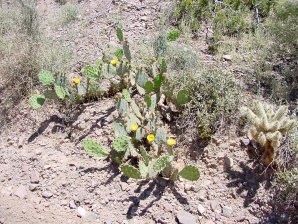 | 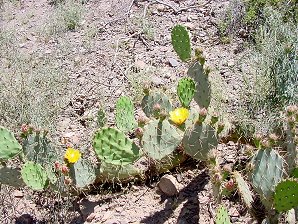 |
| Prickly Pear Cactus About A Dozon Species Genus Opuntia | Englemann's Prickly Pear Opuntia engelmannii Photos In A Dry Year. Same Area As Above Photo |
|---|---|
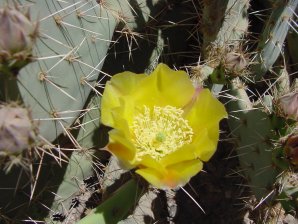 | 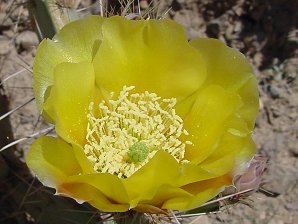 |
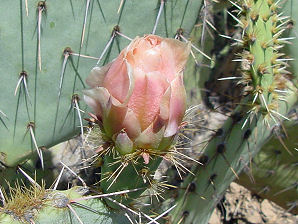 | 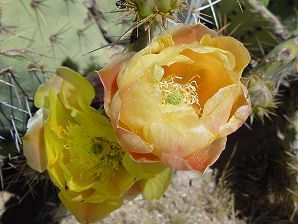 |
| Flower Buds Are Pink. | Turning To Yellow. |
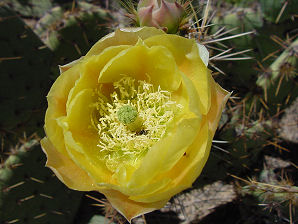 |  |
| Bees Love Prickly Pear Flowers. | Prickly Pear Fruit. |
 /
/

Prickly Pear Cactus.
We wish to thank Wikipedia, the free encyclopedia for some of the information on this page. We share images and information with Wikipedia. There are currently 6 different varieties of Opuntia engelmannii recognized. Opuntia like many others is a trouble free plant to maintain. It is extremely drought tolerant, cold hardy and a fast grower. Extra water during the dry summer months is encouraged but seldom needed. It is easily attacked by the cactus beetle, and can be infested by Cochineal insects that can eventually kill or damage the stems. Extra care should be given to avoid those predators. The fruit is a big favorite among the bird population during August. This familiar paddle-shaped, needle-infested pads form chains as they grow across the desert floor. When the pads have contact with the soil underneath, they will sometimes separate from the mother plant and take root on their own. The pads then grow outward, the new plants forming pokey clusters of cacti 3 feet high and up to 20 feet around. Prickly pears grow prostrate or spread out along the ground. Ranchers and farmers in the Southwest used to plant them to form living fences. They grew in clusters and all one had to do was break off a pad from a living plant and shove it into the earth, and a new plant would grow. Best of all, the vicious spines kept just about anything � man or livestock � from crossing the barrier. Red-brown and flattened, the spines grow in separated clusters that become denser at the top of the pad. All species of prickly pear also have glochids. These tiny needle-like protrusions grow hidden at the top of the spine clusters, often disguised by soft-looking fuzzy patches. So small that you can hardly see them, these yellow and red needles stick easily into prying fingers and are difficult to remove. Like other cacti, the prickly pear is a succulent. It stores water in the flesh of its pads to survive in the arid heat of the desert. During droughts ranchers burn off the spines and feed prickly pears to their livestock. Because they contain so much water, they can even replace the animals� drinking water. Sheep have been known to survive on nothing but prickly pear for up to 8 months. The pads of the prickly pear are actually modified branches or stems. They store the water, carry on photosynthesis and produce flowers. Distinctive of the brown-spined prickly pear, the pads are bluish-green in color and oblong in shape. They grow between 4 to 6 inches wide. Sometime in May or June the prickly pears bloom. The yellow flowers often have red streaks around the base and grow to about 3 to 4 inches wide. Each pad produces several flowers, and when the blooms fade they give way to red, fleshy fruit. The fruit will stay on the plant until it is picked by man, animal or bird. Both the fruit and the pads of the prickly pear are edible and used in many ways. People enjoy the fruit raw or cooked, boiled into jelly, or even fermented to make alcohol. The fruits are called cactus pears, prickly pears or tunas. Full of tiny black seeds that are edible, many Native Americans would dry out the seeds and grind them into pastry flour. The pads, called nopales, are also eaten raw or cooked. Named for its pear-like shape and size, Prickly pear fruit comes from any of several varieties of cacti. Its prickly skin can range in color from green to purplish-red; it's soft, porous flesh (scattered with black seeds) from light yellow-green to deep golden. Also called cactus pear, the prickly pear has a melon-like aroma and a sweet but rather bland flavor. It's extremely popular in Mexico, Central and South America, the Mediterranean countries and southern Africa, and is slowly gaining favor in the United States. Prickly pears are available in Mexican markets and some specialty produce markets from fall through spring. Choose fruit that gives slightly to palm pressure. It should have a deep, even color. Ripen firm prickly pears at room temperature until soft. Store ripe fruit in the refrigerator for up to a week. Prickly pears are usually served cold, peeled and sectioned with the seeds removed. Native Americans also found other parts of the cactus useful. The strong skin fibers of the pads were dried and woven into baskets, mats and fans. The large spines made good toothpicks, needles and pins. Even the woody skeletons left after the flesh dried was used to make furniture and to construct houses. Prickly Pears grow in dry, rocky slopes and flats as well as forests and mountain foothills. Ranging in elevation from 0 to 8,000 feet, Click Here To See Our Web Page Showing The Very Interesting - Cochineal Beetle - Which Lives On the Purple Prickly Pear Cactus. - Cochineal Insect (Beetle), Dactylopius confusus.
Quick Notes:
Height: This plant can reach around 10 feet in height and 10 or more feet in width. Usually about 5 feet tall.
Flowers: The yellow flowers are about 2 1/2 to 3 1/2 inches in diameter. Sometimes variations of the flower color can occur which is not rare.
Flowering Time: April - June.
Trunk: Upright, trunk-forming segmented cactus, usually single trunked; trunk straight and dark; attractive gold color overall.
Jointed Stalks: Five inches long and about four inches in diameter.
Fruit: The fruit is from green to purplish-red; it's soft, porous flesh (scattered with black seeds) from light yellow-green to deep golden. Also called cactus pear, the prickly pear has a melon-like aroma and a sweet but rather bland flavor. I have even made wine out of this fruit.
Pads: Blue - purple, or magenta cactus pads are 4 to 6 inches in diameter, about 5/8 inches thick. They are almost round and flat. They have 1 or 2 spines per areole and have glochids (little barbed bristles organized in clusters) which can penetrate the skin.
Leaves: Very loosely adhered joints 2-4" long with plentiful sharp spines; gold or straw colored; from a distance the spines give the illusion of a soft or fuzzy appearance. Cactus thorns are modified leaves. Their shape conserves water and adds protection to the cactus plant.
Thorns: White to a golden color, forming dense clusters along the ribs. They are large and slightly hooked.
Found: Native to the Sonoran Desert of Arizona. Texas, southeastern California, and Sonora, Mexico.
Hardiness:
Soil pH requirements:
Sun Exposure:
Elevation: 1,500 - 6,200 Feet.
Habitat: Gravel or sandy flats, mesas, hillsides, & grasslands. A xeriscape landscape plant in some places.
Miscellaneous: Bottom Flowering Photos Taken April 25, 2003 Near Lake Pleasant, Arizona. Note dry conditions. Top Flowering Photo Taken April 21, 2005. A xeriscape landscape plant.
|



We Are Proud Of Our SafeSurf Rating!
Click On Any Of The Following Links By Amazon.Com
For Books, & Videos About Xerioscape Plants Of Arizona & The Southwest USA. No Obligation!
Back To Arizona Wild Flowers Home Page.
Back To Arizona Wild Flowers; Yellow Flowers Page Three.
Back To Arizona Xeriscape Landscaping Main Page.
Back To Xeriscape Cactus Page One.
Back To DeLange Home Page
© 1966 - Present, Audrey, Eve, & George DeLange
| © 1966 - Present, Audrey, Eve, & George DeLange |


